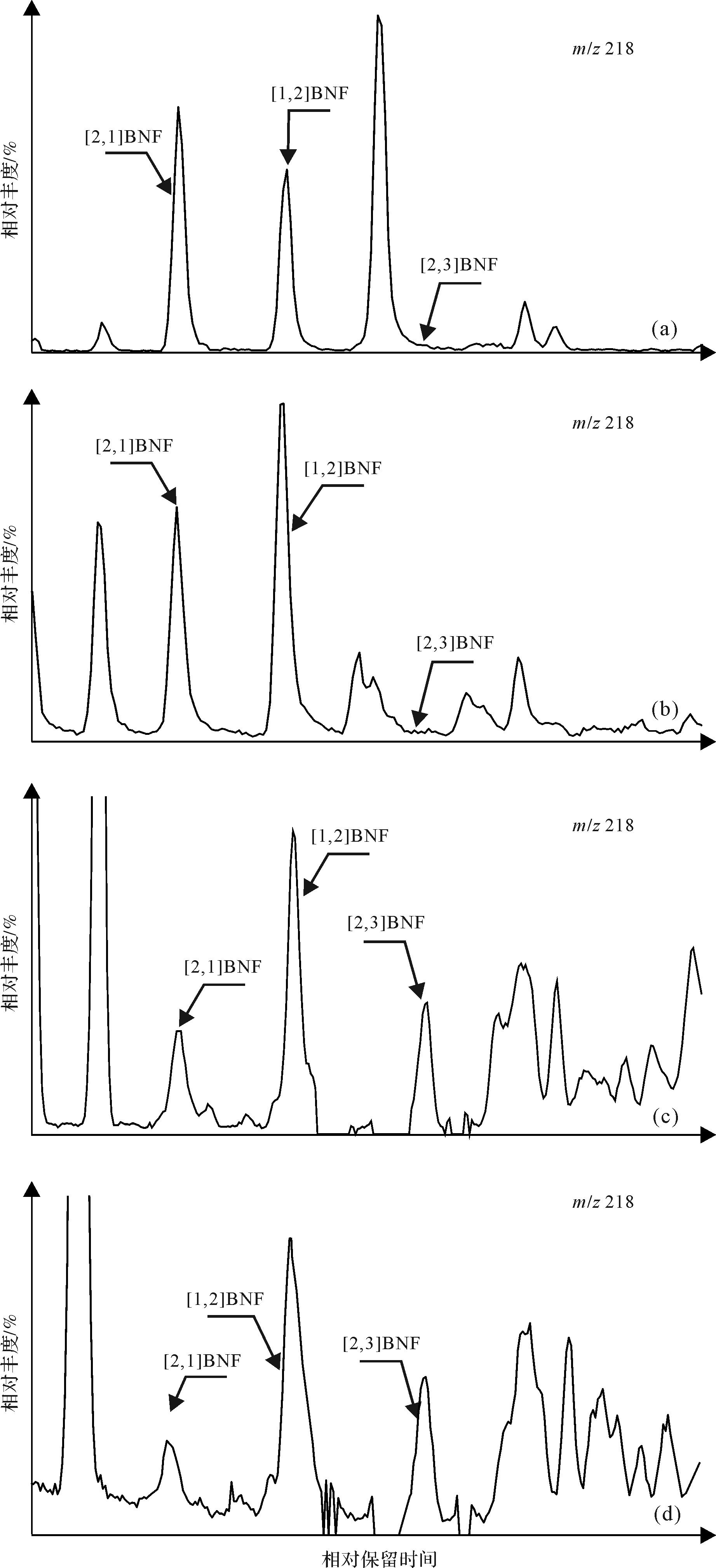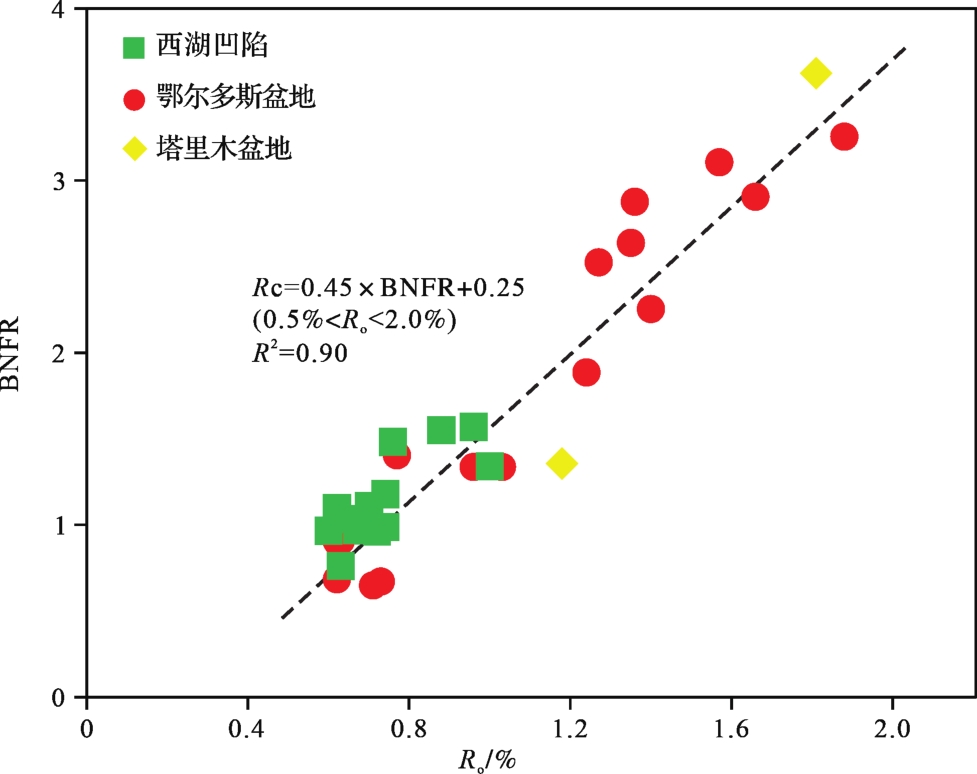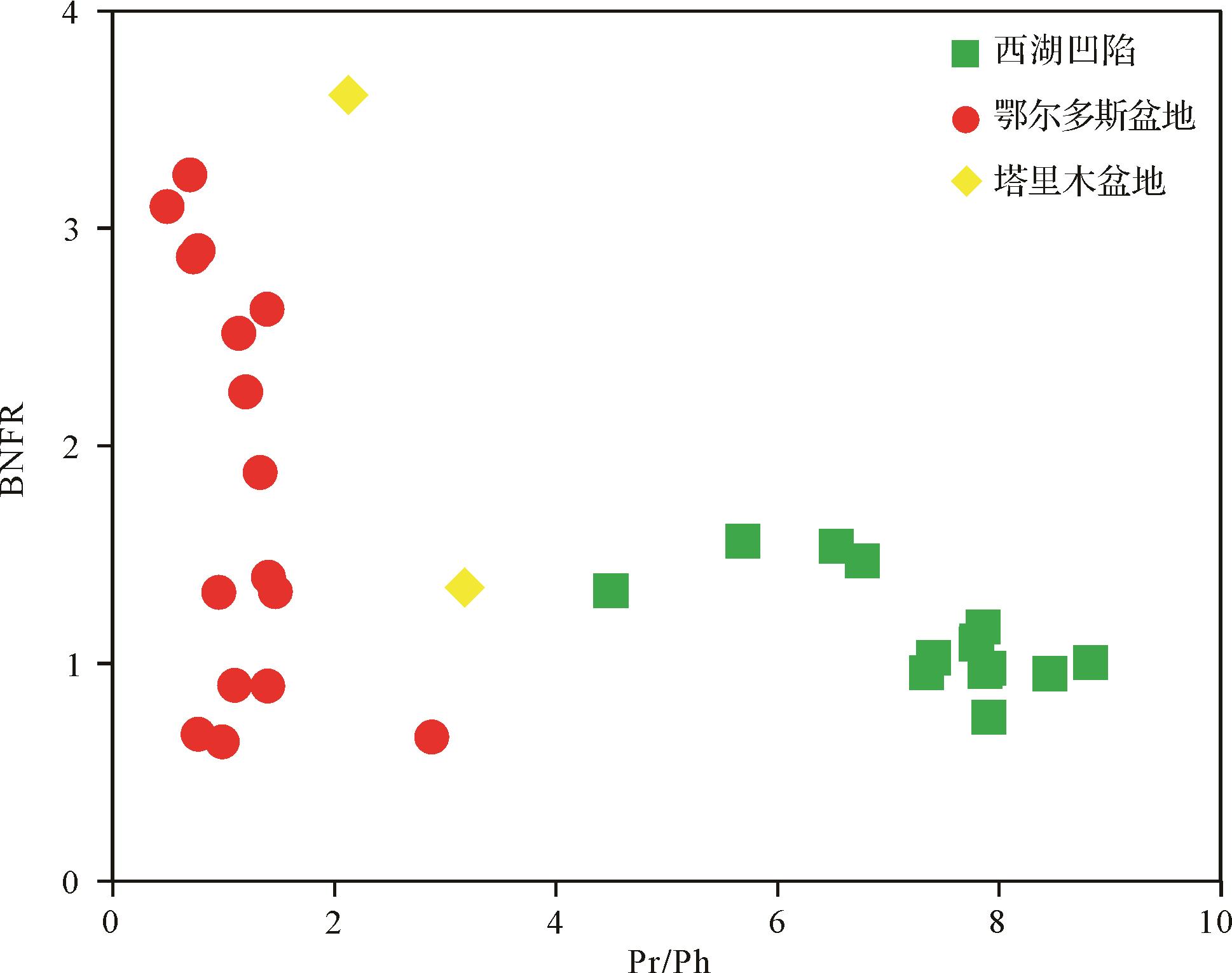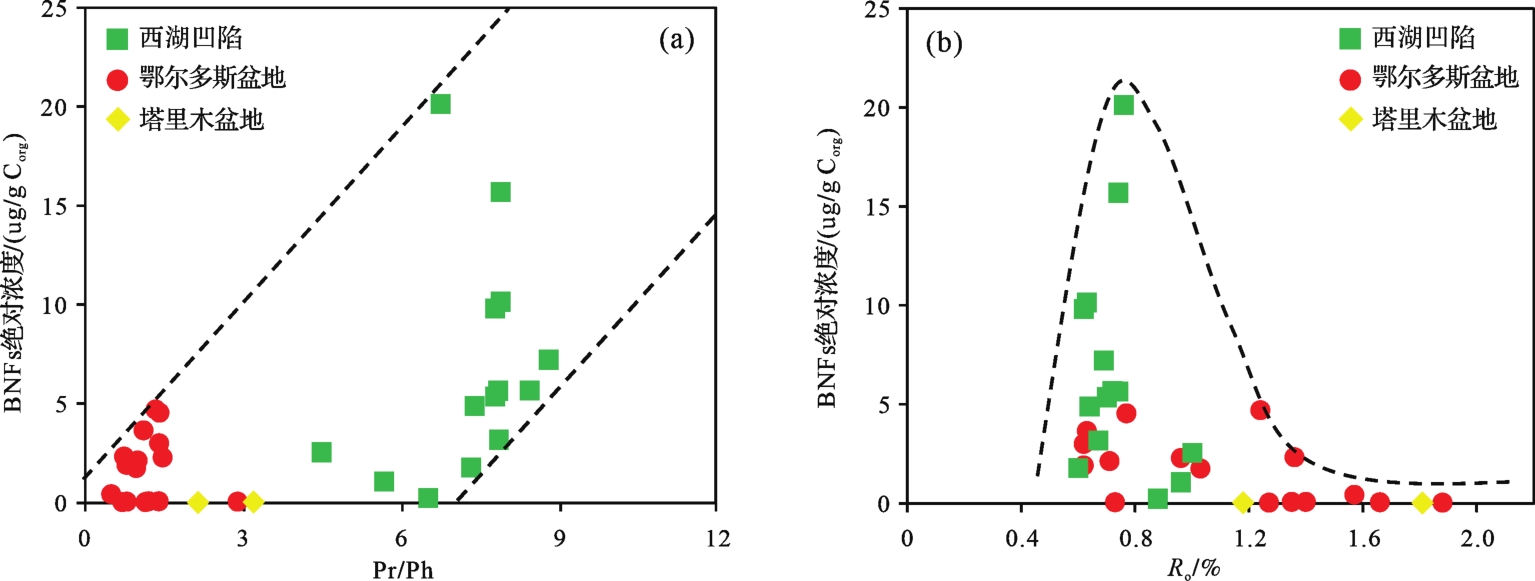HTML
-
二苯并呋喃(DBF)广泛分布在沉积有机质和石油中,对该类化合物检测、分布特征、成因来源及地球化学应用的研究较多,其相关的地球化学指标已广泛应用于原油和烃源岩有机质的沉积环境与有机相判识以及油气运移示踪[1⁃3]。苯并萘并呋喃(BNF)也是一类重要的复杂含氧多环芳烃化合物,但是目前关于其在地质体中的鉴定和地球化学意义的研究较少。
1972年,Shultz[4]在煤的干馏产物中检测到一个苯并萘并呋喃的未知异构体。后来,Borwitzky et al.[5]和Guillén et al.[6]在煤焦油沥青及其挥发物中检测到全部三个苯并萘并呋喃异构体,但具体构型均未被确定。Marynowski et al.[7⁃8]在海相黑色页岩和遭受过野火的含木炭地层的沉积岩中检测到苯并萘并呋喃系列化合物。Li et al.[9]通过标样共注的方法在辽河盆地西部凹陷、塔里木盆地、北部湾盆地福山凹陷、非洲Termit盆地的页岩、碳酸盐岩及相关原油中检测和鉴定了苯并萘并呋喃系列化合物。随后,该系列化合物在黏土岩、页岩、泥岩及原油中陆续被检测发现[10⁃13]。然而,关于苯并萘并呋喃在煤中的检测和鉴定还鲜有报道。
关于苯并萘并呋喃的成因和来源仍不清楚,且相关的研究也非常稀少。Li et al.[9]认为沉积有机质和原油中的苯并萘并呋喃没有明确的生物来源,推测其可能是有机质中的化合物在成岩过程中发生化学反应而形成的。Cesar et al.[12]提出苯并[b]萘并[1,2-d]呋喃在黏土催化作用过程中形成。Marynowski et al.[8]在遭受过野火的含木炭地层中检测到高浓度的苯并萘并呋喃,认为其可能是在燃烧作用过程中形成。
关于苯并萘并呋喃分布的控制因素仍存在争议。Li et al.[9]报道了陆相页岩和海相碳酸盐岩中苯并萘并呋喃的分布不同,但并未解释造成该差异的原因。Cesar et al.[12]提出苯并萘并呋喃的分布主要受沉积环境的影响,成熟度对其分布的影响并不明确,并认为该系列分布的控制因素需要进行更深入的研究。Ogbesejana et al.[13]认为原油中的苯并萘并呋喃的分布主要受运移作用的控制。可见,关于成熟度和沉积环境对苯并萘并呋喃分布的影响是众多学者关注的焦点。
Li et al.[9]提出苯并[b]萘并[2,1-d]呋喃/(苯并[b]萘并[1,2-d]呋喃+苯并[b]萘并[2,1-d]呋喃)可以作为示踪原油运移路径的指标。Cesar et al.[12]提出苯并萘并呋喃异构体的相对丰度分布三角图可以用来进行油源对比,并认为苯并[b]萘并[2,1-d]呋喃与苯并[b]萘并[1,2-d]呋喃的比值可以区分岩性。Ogbesejana et al.[10]认为烃源岩中苯并萘并呋喃的分布能够指示有机质来源。但目前关于煤及煤系烃源岩中苯并萘并呋喃的地球化学意义研究鲜有报道。
鉴于上述存在问题,本文选取东海盆地西湖凹陷古近系、鄂尔多斯盆地石炭系—二叠系和塔里木盆地库车凹陷侏罗系煤样,共计32件。采用标样相对保留时间和标准保留指数对比的方法,系统、明确地鉴定苯并萘并呋喃系列。通过量子化学计算方法,精确计算了该系列的热稳定性大小,分析了成熟度和沉积环境对其分布的影响,初步构建可应用于定量评价烃源岩和原油成熟度的指标,探讨了苯并萘并呋喃在地质体中的成因以及在油气地球化学应用中的启示意义。
-
东海盆地是中国近海海域最重要的含油气盆地之一,它发育于前寒武系和古生界变质基底上,面积约240×103 km2[14⁃15]。西湖凹陷位于东海盆地东北部,面积约为4.6×103 km2,油气资源丰富。西湖凹陷古近系平湖组为一套煤系地层,岩性包括煤、炭质泥岩、泥岩和粉砂岩,发育于半封闭海湾内的湖泊沼泽沉积环境[16⁃18]。本研究选取西湖凹陷平湖组煤14件,镜质组反射率(Ro)为0.60%~1.00%,处于低成熟—成熟阶段,有机质类型为Ⅱ~Ⅲ型,姥鲛烷/植烷比值(Pr/Ph)介于4.50~8.82。
鄂尔多斯盆地位于华北地台的西端,为多旋回叠合克拉通盆地,面积约为37×104 km2[19⁃20]。盆地内广泛沉积了石炭系—二叠系海陆交互相地层,地层中发育多套稳定的煤层[21]。本研究选取鄂尔多斯盆地石炭系—二叠系煤16件,大部分样品Ro介于0.96%~1.88%,成熟度较高,处于成熟—高成熟阶段,有机质类型为Ⅱ~Ⅲ型,Pr/Ph为0.49~2.88。
塔里木盆地位于中国西北部地区,是中国最大的内陆盆地和最重要的油气生产地区之一[22]。库车凹陷位于塔里木盆地北部,凹陷内侏罗系分布多套煤层,沉积环境为三角洲相—湖沼相过渡环境[23]。本文采集了库车凹陷侏罗系煤样2个,样品Ro分别为1.18%和1.81%,处于成熟和高成熟阶段,有机质类型为Ⅱ~Ⅲ型,Pr/Ph为2.13和3.18。
苯并萘并呋喃共有3个异构体,分别为苯并[b]萘并[2,1-d]呋喃([2,1]BNF)、苯并[b]萘并[1,2-d]呋喃([1,2]BNF)、苯并[b]萘并[2,3-d]呋喃([2,3]BNF)。本研究从挪威Chiron科学公司购置了[2,1]BNF和[1,2]BNF标准样品,用于所研究样品中该系列化合物的鉴定。
-
将煤样磨碎至粒径小于0.2 mm(80目),用二氯甲烷作为溶剂,采用索氏抽提的方法,萃取样品中的可溶有机质,抽提时间48 h。用石油醚除去氯仿沥青“A”中的沥青质后,再通过硅胶/氧化铝柱色层法,依次用石油醚、二氯甲烷和石油醚(2∶1,体积比)混合液、二氯甲烷和甲醇(93∶7,体积比)混合液分别洗脱分离出饱和烃、芳烃和非烃馏分,严格执行SY/T 5119—2008行业标准。芳烃馏分和苯并萘并呋喃标样气相色谱—质谱分析均采用Agilent 6890 GC连接的5975i MS(GC-MS)仪器,色谱柱型号为HP-5MS(60 m×0.25 mm×0.25 μm)。仪器运行条件为,色谱的柱箱初始温度为80 ℃,保持恒温1 min,后以3 ℃/min的速率升温,直至310 ℃,再保持恒温16 min。质谱仪离子源为电子轰击(EI),电离能量为70 eV,数据采集方式为选择离子检测和全扫描。
本文煤的镜质组反射率测定仪器为ZEISS Axio Imager 2生物显微镜,外接MPV-SP显微分光光度计,反射率测量量程为0.1%~10.0%,分辨率大小为0.01%,测量过程严格执行SY/T 5124—2012行业标准,每个样品随机反射率测定点数(有效测点数)均大于60个,最后以平均值为样品的实测反射率,保证测得Ro数据准确可靠。
对于某一特定的多环芳烃化合物,在不同的仪器和实验条件下,其保留时间(tR)是有差异的。为了表征其在一定实验条件下色谱柱上的流出特征,便于不同实验室和研究人员之间的对比,普遍采用标准保留指数(I),具体的计算方法见Li et al. [9]。
量子化学计算是成熟的技术,已在分子有机地球化学领域获得了成功的应用[24⁃26]。本论文量子化学计算均采用密度泛函B3LYP方法,具体基组为6-311++G(d,p),在理想状态下获得了各系列异构体的热力学参数,例如,键角、电子能(ΔE)、内能(ΔU)、焓(ΔH)和吉布斯自由能(ΔG)等。
-
对苯并萘并呋喃系统且准确地鉴定是探讨其油气地球化学应用的前提条件。Li et al.[9]首次通过标样共注的方法,在三角洲相页岩、湖相页岩、海相页岩和海相碳酸盐岩及相关原油中明确鉴定了苯并萘并呋喃系列化合物。本研究采用标样相对保留时间和标准保留指数对比的方法,同时与前人的鉴定结果对比,明确鉴定出西湖凹陷古近系、库车凹陷侏罗系和鄂尔多斯盆地石炭系—二叠系煤中的苯并萘并呋喃系列化合物。通过保留指数系统,精确计算出苯并萘并呋喃各异构体的标准保留指数(表1)。由此,确定了各异构体具体的流出位置和顺序(由先到后)为[2,1]BNF、[1,2]BNF、[2,3]BNF(图1),结果与前人结论相吻合[9]。另外,本研究测定的苯并萘并呋喃系列的保留指数与前人的报道基本一致,差别都在±1指数单元以内,考虑到色谱—质谱实验条件和不同色谱柱的影响,认为该误差在合理的范围之内。因此,本文计算的苯并萘并呋喃系列保留指数可以为其他实验室或研究人员在相同实验条件下对该类化合物的鉴定提供依据。
为了确定苯并萘并呋喃各异构体的热稳定性差异,本文通过量子化学计算的方法精确计算了该系列不同异构体的热力学性质,包括ΔE、ΔU、ΔH、ΔG等。本文所计算的热力学能都是以能量最低构型的能量为基准的相对值,将能量最低构型的相对能量定义为0 kcal/mol,其他分子的绝对能量减去能量最低构型的绝对能量得到相应的相对能量值。相对能量值越大,指示该构型在其同分异构体中越不稳定[27]。表2显示,[2,3]BNF的能量最高,ΔG=1.55 (kcal/mol),最不稳定,导致其在低成熟度的煤中以痕量存在。[2,1]BNF的ΔG=0.24 (kcal/mol),热稳定性中等。相比之下,[1,2]BNF的热稳定性最高,这两个异构体均以一定浓度稳定存在于不同成熟度的煤样中。通过量子化学计算,确定出苯并萘并呋喃系列热稳定性顺序为[1,2]BNF>[2,1]BNF>[2,3]BNF。
-
苯并萘并呋喃系列化合物在黏土岩、页岩、泥岩、碳酸盐岩及原油中陆续被检测发现[7,9⁃13]。本文采集的煤中均检测出苯并萘并呋喃系列化合物,表明苯并萘并呋喃广泛分布于沉积有机质。图2展示了不同成熟度煤中苯并萘并呋喃的分布特征,随着成熟度的升高,各异构体的相对含量呈现出[1,2]BNF丰度逐渐增加,而[2,1]BNF逐渐减小的规律性变化,表明成熟度是影响该系列分布特征重要控制因素。总体来看,大部分煤均具低含量的[2,3]BNF,尤其在Ro<0.7%时,[2,3]BNF基本以痕量分布,表明其热稳定性很低。相对而言,煤中[2,1]BNF和[1,2]BNF相对丰度普遍较高,但随着成熟度的增加变化较大。在Ro<0.7%的煤中,[2,1]BNF含量最高,[1,2]BNF含量较低。当Ro>0.7%以后,[1,2]BNF含量最高,[2,1]BNF含量较低。值得注意的是,随着成熟度的增加,[1,2]BNF含量相对于[2,1]BNF表现出增加的趋势,表明[1,2]BNF的热稳定性较高。所以,基于不同成熟度样品中苯并萘并呋喃的分布特征,推测该系列的热稳定性大小顺序为:[1,2]BNF>[2,1]BNF>[2,3]BNF,与量子化学计算的热稳定性顺序相吻合。总体来看,随着成熟度的增加,由于[1,2]BNF相对于[2,1]BNF的热稳定性更大,[1,2]BNF的丰度相比于[2,1]BNF也呈现逐渐增加的趋势,表明成熟度是控制该系列分布的重要因素。
基于地质数据和量子化学计算的结果,以苯并萘并呋喃系列异构体之间的热稳定性差异为原理,提出成熟度参数苯并萘并呋喃比值(BNFR=[1,2]BNF/[2,1]BNF)。图3展示了苯并萘并呋喃比值(BNFR)与镜质组反射率(Ro)的关系,BNFR随着Ro的升高而增加,两者具有良好的正相关关系,相关系数达到0.90,表明苯并萘并呋喃比值是潜在的成熟度指标。另外,本文初步建立了通过BNFR定量评价成熟度的公式Rc=0.45×BNFR+0.25 (0.5%<Ro<2.0%),认为该参数是定量评价低成熟—高成熟烃源岩(Ⅱ~Ⅲ型干酪根)及其相关原油成熟度的潜在指标。
-
苯并萘并呋喃比值能否成功应用于指示有机质成熟度,还需要研究有机质沉积环境对它的影响,而前人并未进行这方面的探讨。有机显微组分能够指示有机质生源,镜质组和惰质组主要来源于高等植物木质素和纤维素,壳质组来源于高等植物类脂膜,腐泥组主要来源于藻类[28]。C29甾烷主要来源于高等植物,而C27甾烷主要由藻类贡献[29⁃30]。本研究中煤样的有机显微组分基本相同,以镜质组和惰质组为主(>90%),壳质组含量较低,腐泥组基本未观测到。另外,煤中甾烷的分布以C29甾烷为主,C27甾烷含量很低。从有机显微组分和甾烷的分布特征来看,本研究中煤样的有机质生源母质基本相同,主要为陆源高等植物来源。
姥鲛烷/植烷比值作为良好的沉积环境指标,已广泛应用于指示有机质沉积时的氧化还原环境[30⁃31]。从图4中可以看出,BNFR与Pr/Ph没有明显的相关性。当煤沉积于还原环境时(Pr/Ph<2.5),其BNFR变化范围很大,介于0.65~3.62;沉积于氧化环境中的煤(Pr/Ph>2.5),随着Pr/Ph的升高,BNFR基本保持不变,介于0.67~1.57。结果表明,沉积环境的氧化还原性对BNFR的影响很小。因此,苯并萘并呋喃比值可作为有效的成熟度指标,对于氧化—还原环境的沉积有机质均具有较好的适用性。
-
为了探讨地质体中苯并萘并呋喃的成因,研究了煤中BNFs(代表3个苯并萘并呋喃异构体的总量)的绝对浓度与Pr/Ph和Ro的关系。从图5a可以看出,随着Pr/Ph的增加,BNFs的绝对浓度总体呈现增加的趋势,表明氧化条件可能有助于BNFs的形成。值得注意的是,随着成熟度的升高,BNFs的绝对浓度总体呈现先增加后减小的变化趋势。当煤样的成熟度较低时(Ro<0.9%),BNFs绝对浓度随着成熟度的升高逐渐增加。然而,当煤样达到高热演化阶段以后(Ro>0.9%),随着成熟度的增加,BNFs绝对浓度逐渐降低(图5b)。上述现象表明,BNFs的形成可能发生在后生作用阶段早期,热降解作用可能导致BNFs含量在生油高峰以后下降。因此,煤中的苯并萘并呋喃可能来源于后生作用,可能是较高热演化阶段转化为更加稠合的多环芳烃化合物的中间产物。
Li et al.[9]提出[2,1]BNF/([1,2]BNF +[2,1]BNF)可以作为示踪原油运移路径的指标。Cesar et al.[12]认为[2,1]BNF/[1,2]BNF可以区分岩性,并应用于油源对比。Ogbesejana et al.[10]认为苯并萘并呋喃的分布特征能够指示有机质来源。此次研究发现,[1,2]BNF和[2,1]BNF的相对丰度明显受成熟度的影响,指示我们在应用其相关的参数时须谨慎,[2,1]BNF/[1,2]BNF应用于示踪原油运移路径和油源对比的前提条件是成熟度大致相同。本论文研究成果可以为苯并萘并呋喃相关参数合理应用于油气地球化学研究,提供一定的借鉴依据。
3.1. 苯并萘并呋喃鉴定及热稳定性
3.2. 成熟度对苯并萘并呋喃分布的影响
3.3. 成熟度对苯并萘并呋喃分布的影响
3.4. 苯并萘并呋喃成因及地球化学应用启示
-
(1) 系统、准确地鉴定了煤中苯并萘并呋喃系列化合物,确定了其具体的流出位置和顺序为[2,1]BNF、[1,2]BNF、[2,3]BNF。采用量子化学计算方法,精确计算出苯并萘并呋喃系列的热稳定性顺序为[1,2]BNF>[2,1]BNF>[2,3]BNF。
(2) 在一定成熟度范围内(0.5%<Ro<2.0%),煤样中BNFR与Ro之间具有很好的正相关关系,表明该指标可用于定量评价低熟—高成熟阶段烃源岩(Ⅱ~Ⅲ型干酪根)及原油的成熟度。
(3) 煤中的苯并萘并呋喃主要在后生作用阶段形成,这可能是高热演化阶段形成更稠合多环芳烃过程中的中间产物。




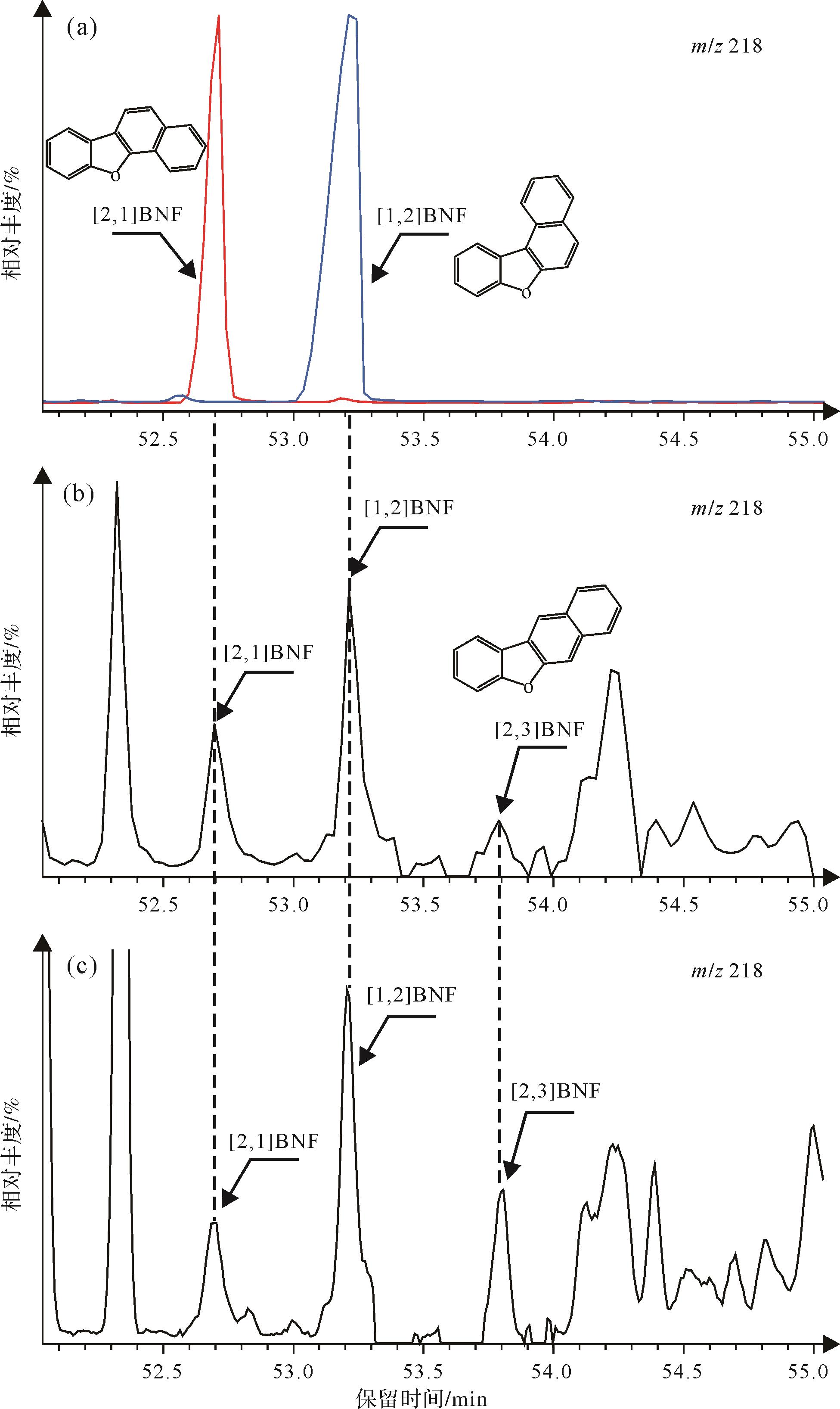







 DownLoad:
DownLoad:
